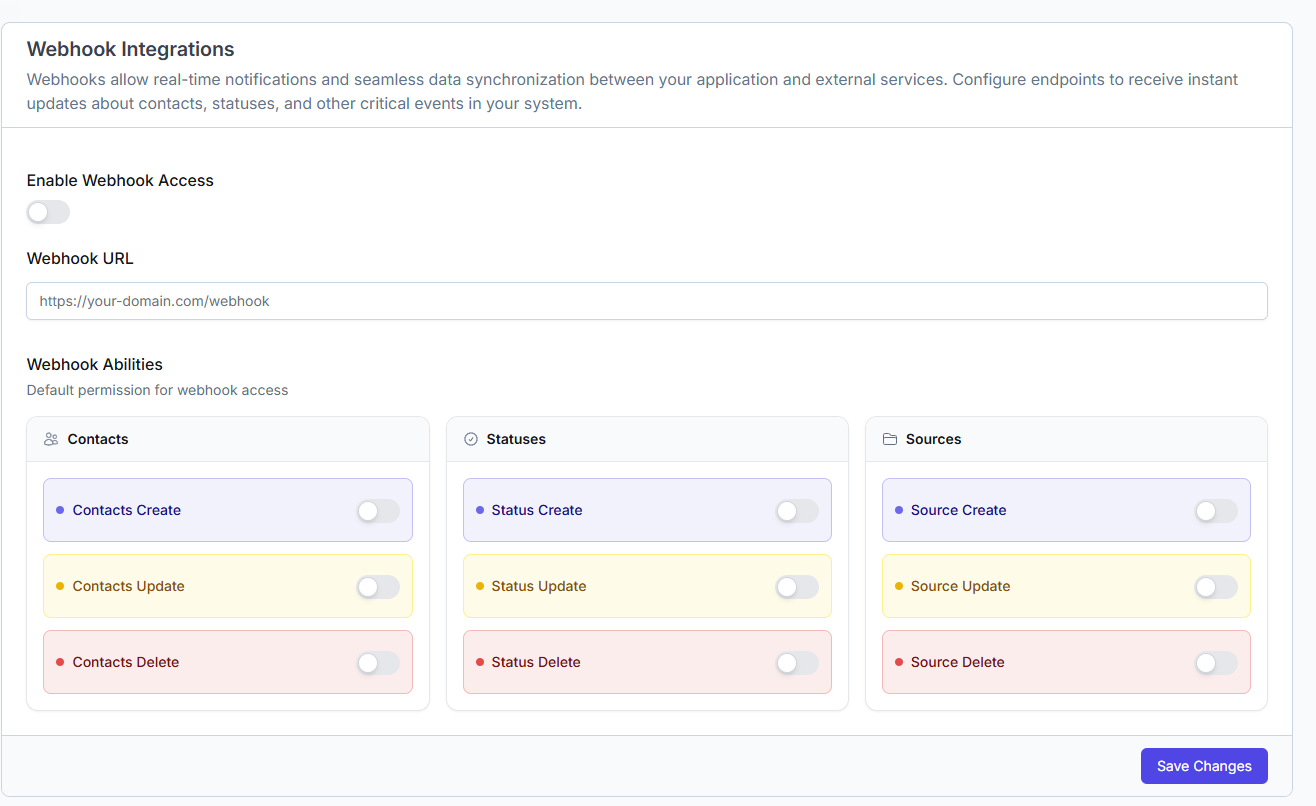Webhook Management - Webhook Integrations
Webhooks let your app instantly receive updates when something important happens — no need to keep checking manually.
This allows your app to:
- Sync data in real-time
- React immediately to changes
- Stay up-to-date without extra effort
For example, when a contact is updated in WhatsMark, your system gets notified instantly and can take action — like updating your CRM or triggering a workflow.
Key Benefits
- Real-time updates without polling
- Faster automation and integrations
- Smarter workflows with minimal delay
Just set your webhook URL, choose what events you care about, and let WhatsMark handle the rest.

Enable Webhook Access
At the top of the Webhook settings panel, you'll see a toggle switch that controls whether webhooks are active for your account.
- Enabled (switch ON): WhatsMark will start sending real-time event data to your configured webhook URL(s) based on the events you've selected.
- Disabled (switch OFF): No webhook data will be sent, even if you’ve entered a URL or selected events.
Webhook URL
Enter the URL endpoint where you want WhatsMark to send real-time notifications.
This is the web address on your server (or app) that will receive event data (like new contacts, status updates, etc.) via HTTP POST requests.
Without a webhook URL:
- WhatsMark can’t deliver event data.
- Your app won’t receive any real-time updates.
Example
https://your-domain.com/webhook
Requirements
- Must be publicly accessible
- Should accept POST requests with JSON payloads
- Add security (e.g., secret keys or headers) to verify incoming requests
Webhook Abilities
Choose the specific events that should trigger webhook notifications. This allows you to control exactly what kind of data your system receives from WhatsMark in real time.
The events are grouped into three categories: Contacts, Statuses, and Sources.
| Event Type | Trigger Condition | Description |
|---|---|---|
| Contacts Create | When a new contact is added | Sends data when a new contact is created in WhatsMark. |
| Contacts Update | When an existing contact is modified | Notifies you when contact info (like name, number, tags) is updated. |
| Contacts Delete | When a contact is removed | Alerts you when a contact is deleted from the system. |
| Status Create | When a new status is created | Triggers when a new status (e.g., lead status) is added. |
| Status Update | When an existing status is changed | Sends updates when status names or settings are modified. |
| Status Delete | When a status is deleted | Notifies when a status entry is removed from your account. |
| Source Create | When a new source is added | Triggers when a new source (e.g., campaign source or channel) is created. |
| Source Update | When a source is edited | Sends data when the source details (like name or type) are changed. |
| Source Delete | When a source is deleted | Alerts you when a source is removed from your system. |
💡 Tip: You can enable any combination of these events based on your integration needs.
Saving Changes
After configuring the webhook URL and selecting the desired webhook abilities, click the Save Changes button to apply your settings.
Notes:
- Make sure your webhook URL is publicly accessible and able to accept POST requests.
- You can customize webhook permissions to restrict or allow specific event notifications.
- Webhooks provide instant and automated data synchronization to enhance your integration workflows.